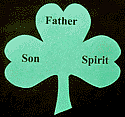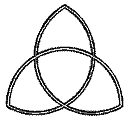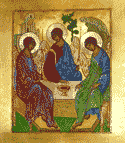 St Mary's Church, Dymock
St Mary's Church, Dymock
| Admin | |||
| . | Home | Contents | |
| H&S Policy | People Safety | Grave Yard | |
The Church & The World
Faith & Care
Faith & Care
Things Past
People & Features
People & Features
Seasons and Festivals

As well as the Seasons and Major Festivals, the church celebrates several 'Special Days' throughout the year to remember, honour or support our work in God's world. Celebration of the Special Days is usually optional, Christians chose which they want to include. Click here to view the 'Special Days'.

.
The word Trinity comes from the Latin 'Trinitas' which itself comes from the Latin 'Trinus' meaning 'threefold' and refers to the essence of the one and only God as having three 'parts' (see below). The idea of God as Trinity is unique to the Christian faith and can be one of the most difficult things for some people to understand.
What is God Like?

The Triquetra figure
is a good description of the Trinty. It's a symmetrical
arrangement of three separate arcs all needed to make a single whole.
.
Immediately after Jesus had ascended back to heaven, the Christian church began to be formed; first by the Apostles going out into the world as Jesus had intended and then by their successors. For the first three centuries, several theories were put forward to define how God could be one but at the same time three, Father, Son and Holy Spirit, but each theory was found to have a flaw that failed to take into account all the concepts, so each was declared a heresy (at odds with conventional belief) until, at a great Council in Nicaea in 325AD when all the bishops were represented and a formula was agreed that satisfies all the facts - the concept of the Trinity. This states that there is only one God who has only one 'substance' but that he comprises three separate 'parts' who are in perfect relationship with each other - a great example to humanity of mutual love and respect. (Return to top)
Three 'Persons' - One 'God'

It's clear from this argument that God is infinitely more clever than humans - he's not human, he's God - but we have to use our limited human brainpower and language to describe him. It doesn't seem right to describe God as 'it' or 'thing', the highest intelligence in the human language is the 'person', so God is described as three persons in one God - a 'Trinity'.
The Trinity in Art

The problem for all artists is that they can depict three persons but it's very difficult to depict three persons in one unity! Depiction of three persons like this sometimes leads others to think Christians believe in three Gods. That's not true - Christians definitely believe that there is one and only one God
One way to think of the Trinity is to consider water which can be ice, liquid, and steam. Three modes but one substance - H2O. Although this seems a useful example, it's actually a heresy as the three 'modes' can only exist at different times, whereas God is three parts of a single substance all at the same time. The better example is the 'Triquetra' figure shown above which has three separate arcs, but all are necessary to make a single whole. (Return to top)